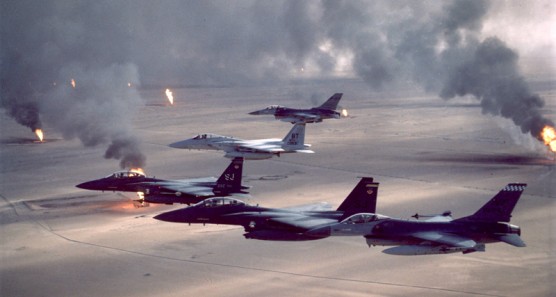By Senior Airman Hailey Haux, Secretary of the Air Force Public Affairs
Twenty-five years ago, the Air Force participated in Operation Desert Storm, the largest air campaign since the conflict in Southeast Asia. The campaign’s purpose was to drive the Iraqi military out of Kuwait, release the country from Saddam Hussein’s invasion and reestablish its sovereignty.
On the morning of Aug. 2, 1990, Iraq invaded nearby Kuwait. In less than four hours, Iraqi forces occupied the capital, Kuwait City, and Hussein soon annexed the country as the 19th province of Iraq. The U.S. government initiated Operation Desert Shield in response.
Several months later on Jan. 16, 1991, following Congressional concurrence with United Nations efforts to enforce a resolution that demanded Iraq’s withdrawal from Kuwait, Desert Storm was launched.
“The real mission, the immediacy of that mission … was to deploy as many forces as possible to deter further aggressiveness by the Iraqi military and of course the Air Force was the first on the list, along with the Navy and the aircraft carriers, to deploy in the region,” said retired Lt. Gen. Bruce A. “Orville” Wright, a Desert Shield/Storm veteran. “It was a rapid deployment of forces from the continental United States (and some forces from Europe) to put enough airpower in place so the Iraqi military would be discouraged, if not deterred.
“We took out their eyes and ears, their control capability,” he continued. “The entire ground operations lasted about 100 hours and that’s a credit to the joint coalition airpower that was employed against the Iraqi military. We were all excited, that’s what we trained for our whole career. To take 24 F-16s and a squadron of very capable highly-trained pilots and maintenance professionals … and defeat what was then the largest ground force.”
The air campaign marked the initial phase of the war and for the Air Force, air superiority was the goal. With more than 68,800 total force Airmen being rapidly deployed in support of Desert Storm, there were approximately 69,406 sorties flown by 30 different types of aircraft.
“I remember thinking, ‘Saddam Hussein has no idea what’s coming,’ and after the first 60 minutes of the war, he will be largely disconnected from his tactical forces and he was. They tried to reconnect, but in many ways we began the decapitation of the leadership within the first 15 minutes of the war,” said Maj. Gen. Paul T. Johnson, an operational capability requirements director and Desert Shield veteran. “I really hope we can remember how we came together as a joint and a coalition team, nations from all over the world, all of the services supporting each other, generating effects for one another to achieve an effect in an incredibly short period of time.”
Desert Storm marked the first conflict in history to make comprehensive use of stealth and space systems support capabilities against a modern, integrated air defense, allowing the Air Force to succeed in their endeavor of air superiority.
“Over time I have come to understand the enabling capabilities that came to us from space, came to us out of stealth (and) that came to us out of new weapons and ammunitions that allowed us to do things in ways that we hadn’t done them before,” Johnson said. “Our ability to dynamically command and control across an entire theater there were things that, looking back now in hindsight, fundamentally began the transformation of airpower. There are so many things that we take for granted today … that saw their beginnings in Desert Storm.”
As with any mission, operation or task, there are lessons learned. Desert Storm taught the Air Force that being on the cutting edge of revolutionary technology is critical to success.
“That was the first time the investments, that had been made in some cases a decade or two decades earlier, came together on the battlefield and for the first time the world saw what the United States Air Force could do,” said Air Force Secretary Deborah Lee James. “Looking back and learning from Desert Storm, it is more important than ever before that we continue to modernize our force, gaining the advantage to defeat any adversary we may face in the future.”
On Feb. 28, 1991, following six weeks of air attacks and 100 hours of a ground campaign, President George H.W. Bush declared a cessation of operations and announced that Kuwait had been liberated.
“The memories and lessons learned from Desert Storm continue to define today who we are,” Wright said. “We have the ability to defend the nation that’s founded on, not just the history of Desert Storm but the history of airpower from World War I to World War II to Korea, Vietnam, Desert Storm and today. We have been in this fight now for 25 years and those Airmen who are out there today are critical. They are critically important to the safety of our fellow citizens and critically important to the future of the United States of America.”

Like this:
Like Loading...
Related





 Tweet This
Tweet This Facebook
Facebook Digg This
Digg This Bookmark
Bookmark Stumble
Stumble RSS
RSS



























REAL NAMES ONLY: All posters must use their real individual or business name. This applies equally to Twitter account holders who use a nickname.
0 Comments
You can be the first one to leave a comment.